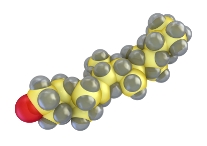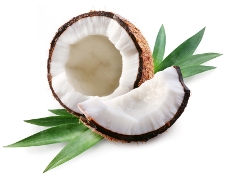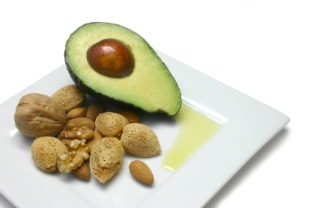Saturated vs. Unsaturated | Essential vs. Non-essential | Size Matters | What Do We Eat?| References
 Fat makes you fat. Right? That’s what we’ve been told over and over again by the medical establishment for the last 50 years. But, are all fats created equal? Is 100 calories of butter the same as 100 calories of margarine? Or bacon? Or olive oil? We’ve been told that the worst fats, the ones most likely to clog our arteries, are saturated fats. But are ALL saturated fats bad? Lately, there has been a ton of buzz about the horrors of trans-fats. What are these evil things, and are they really that bad for us? And how is it that these trans-fats so vilified today were considered health foods in the 1970s? Fat makes you fat. Right? That’s what we’ve been told over and over again by the medical establishment for the last 50 years. But, are all fats created equal? Is 100 calories of butter the same as 100 calories of margarine? Or bacon? Or olive oil? We’ve been told that the worst fats, the ones most likely to clog our arteries, are saturated fats. But are ALL saturated fats bad? Lately, there has been a ton of buzz about the horrors of trans-fats. What are these evil things, and are they really that bad for us? And how is it that these trans-fats so vilified today were considered health foods in the 1970s?
It turns out that fats are not all equal at all. There are a number of types of fats, and a number of things to consider when discussing which are good, which are bad, and which are downright evil for your health.
Fat (also known as lipid), is one of the three classes of nutrients; the other two are proteins and carbohydrates. The major function of fat is to provide energy for the body. Pound for pound, fat contains more energy (calories) than protein and carbohydrates. There are three types of fat:
1. triglycerides
2. cholesterol
3. phospholipids
Triglycerides are where most of the fat calories are stored. In addition to providing energy, fat serves other functions. For example, cholesterol and phospholipids are components of cell membranes and sheaths surrounding nerve cells. Cholesterol is also important for the production of bile acids, hormones, neurotransmitters, and vitamin D. (6) back to top
 What is the difference between saturated and unsaturated fat? It’s all in the chemistry. All fats (or fatty acids as they are called in the chemistry world) are made up of a carboxyl group attached to chains of carbon atoms which are connected to each other along with atoms of hydrogen. Each carbon atom is able to make four bonds with other atoms. Sometimes these are double bonds in which the carbon forms two bonds with the next carbon atom in the chain. What is the difference between saturated and unsaturated fat? It’s all in the chemistry. All fats (or fatty acids as they are called in the chemistry world) are made up of a carboxyl group attached to chains of carbon atoms which are connected to each other along with atoms of hydrogen. Each carbon atom is able to make four bonds with other atoms. Sometimes these are double bonds in which the carbon forms two bonds with the next carbon atom in the chain.
Saturated fat is fat that consists of triglycerides containing only saturated fatty acids. Saturated fatty acids have no double bonds between the individual carbon atoms of the fatty acid chain. That is, the chain of carbon atoms is fully "saturated" with hydrogen atoms. There are many kinds of naturally occurring saturated fatty acids which differ mainly in number of carbon atoms, from three carbons (propionic acid) to 36 (hexatriacontanoic acid). (10) Saturated fat sources in the diet include butter, bacon, lard, tallow, fat in meat, palm oil, coconut oil, and others.
An unsaturated fat is a fat or fatty acid in which there is at least one double bond within the fatty acid chain. A fat molecule is monounsaturated if it contains one double bond and polyunsaturated if it contains more than one double bond. Where double bonds are formed, hydrogen atoms are eliminated.
Unsaturated fats can occur with the hydrogen atoms in one of two conformations, cis and trans (of trans-fats). In the cis conformation, hydrogen atoms are on the same side of the double bond, whereas in the trans conformation they are on opposite sides. Thus, unsaturated fats may take one of two forms depending on where the hydrogen atoms are in the molecule. Unsaturated fats include canola oil, corn oil, soybean oil, “vegetable oil”, and others. Avocados, olives, and nuts are whole foods sources of unsaturated fats. However, most whole foods contain a combination of saturated and unsaturated fats.
Saturated fats are typically solid at room temperature. Because there are no double bonds and every carbon is fully bonded to hydrogen atoms, saturated fats are extremely stable and are not prone to oxidation. Unsaturated fats are typically liquid at room temperature, and their double bonds make them less stable than saturated fats. This means they are more prone to oxidation. Oxidation leads to rancidity, and rancid fats are terrible for our bodies.
Hydrogenated and partially hydrogenated fats have been chemically treated to add hydrogen atoms to an unsaturated fat in order to make it more stable and solid at room temperature. Hydrogenation of fatty acids requires extremely high temperatures and a metal catalyst which may or may not be completely removed from the finished product.
Conventional medical wisdom has dictated that saturated fats, being hard at room temperature, are more likely to clog your arteries and should therefore be avoided. However, modern research suggests that inflammation is a bigger factor in atherosclerosis and other heart disease than the amount of fat consumed. Rancid unsaturated fats are a major dietary source of inflammation, and may prove to be more of an issue for heart disease than saturated fat. Since the introduction of margarine in the 1970s and the campaign against butter and other animal-based fats, incidences of heart disease and other illnesses have increased significantly. back to top
 If we’re trying to avoid fat, why are some fats called “essential”? It turns out that there are some fats we are unable to make which our bodies require for a variety of metabolic processes. These fats must then be taken in through our diets in order for us to be healthy. Only two EFAs (essential fatty acids) are known for humans: alpha-linolenic acid (an omega-3 fatty acid) and linoleic acid (an omega-6 fatty acid). (3,4,9) Other fatty acids that are only "conditionally essential" include gamma-linolenic acid (an omega-6 fatty acid), lauric acid (a saturated fatty acid), and palmitoleic acid (a monounsaturated fatty acid). (4) If we’re trying to avoid fat, why are some fats called “essential”? It turns out that there are some fats we are unable to make which our bodies require for a variety of metabolic processes. These fats must then be taken in through our diets in order for us to be healthy. Only two EFAs (essential fatty acids) are known for humans: alpha-linolenic acid (an omega-3 fatty acid) and linoleic acid (an omega-6 fatty acid). (3,4,9) Other fatty acids that are only "conditionally essential" include gamma-linolenic acid (an omega-6 fatty acid), lauric acid (a saturated fatty acid), and palmitoleic acid (a monounsaturated fatty acid). (4)
Alpha-linolenic acid (LNA or ALA) belongs to the omega-3 family of fatty acids. You can find ALA in flax (abundantly), and in small quantities in walnuts, cold pressed canola oil, wheat germ (the part taken out when making white flour), and dark green leafy vegetables (in tiny amounts).(11)
These foods are not especially popular in the typical American diet, so it is no wonder that about 95-99% of the US population is deficient in the essential fat ALA. This deficiency plays a role in practically all degenerative diseases like heart disease and cancer, arthritis, skin conditions, diabetic neuropathy, immune function, and premenstrual syndrome. (11)
Linoleic acid (LA) is the other essential fatty acid, belonging to the omega-6 family of fatty acids. It is found abundantly in soy oil, sunflower seeds, safflower seeds, pumpkin seeds, sesame seeds, tahini, corn oil, and in most nuts. The typical American diet contains too much LA in comparison to ALA. (11)
The right ratio of linoleic acid versus alpha-linolenic acid in the diet is important. It should be around 3:1 or 2:1, meaning two to three times as much LA as ALA. Typically in the American diet this ratio is more like 20:1. Some researchers believe an imbalance may lead to a variety of mental disorders, including hyperactivity, depression, brain allergies, and schizophrenia. (11)
DHA and EPA, while technically non-essential, are essential fatty acids for many of us, because while our bodies should be able to make these from ALA, it has been proven that in many people this conversion process does not happen efficiently. It appears that for most people, DHA and EPA become essential fats that we need to get from diet. (11)
Omega-3 fatty acids are unsaturated fats with the double bond in the third carbon position. Omega-6 fatty acids from our diet have the double bond at the sixth carbon position. Our bodies require an appropriate balance of omega-3 and omega-6 essential fatty acids for all of our metabolic processes to work correctly. Too much omega-6 can lead to inflammation and heart disease, but too little can also cause problems. Omega-3 fatty acids are generally considered to be anti-inflammatory and good for our bodies and our hearts, which is the reason for the popularity of fish oil supplements. back to top
In addition to saturated versus unsaturated and omega-3 versus omega-6, there is the issue of chain length. Fats are made up of chains of carbon atoms, bound either together with double bonds or bound to each other plus hydrogen atoms.
Short-chain fatty acids contain fewer than six carbon atoms.
 Medium-chain fatty acids contain six to twelve carbon atoms. Medium-chain fatty acids have a different pattern of absorption and utilization than long-chain fatty acids that make up 97% of dietary fats. (5,6,7) Medium-chain fatty acids contain six to twelve carbon atoms. Medium-chain fatty acids have a different pattern of absorption and utilization than long-chain fatty acids that make up 97% of dietary fats. (5,6,7)
Up to 30% of medium-chain fatty acids are absorbed intact across the intestinal barrier and directly enter the portal vein. This allows for much quicker absorption and utilization of medium-chain fatty acids compared to long-chain fatty acids.
Long-chain fatty acids contain 13-21 carbon atoms. (1) 97% of dietary fats are long-chain fatty acids, and they are digested and metabolized in a completely different way than medium-chain fatty acids. They are also more prone to oxidation than their shorter chained cousins.
Very-long-chain fatty acids contain more than 22 carbon atoms. These fatty acids need to be broken down into smaller bits in order for your cells to use them for energy. (10)
Short and medium-chain fatty acids are absorbed directly into the blood via intestine capillaries and travel through the portal vein just as other absorbed nutrients do. However, long-chain fatty acids are not directly released into the intestinal capillaries. Instead they are absorbed into the fatty walls of the intestine villi and reassembled again into triglycerides. The triglycerides are coated with cholesterol and protein (protein coat) into a compound called a chylomicron. (10) back to top
 The way I see it, aside from trans conformation unsaturated fatty acids, there really is no such thing as a “good fat” or a “bad fat”. We need saturated and unsaturated fats for our bodies to work properly. We need long, medium, and short chain fatty acids for various physiological processes. We need both omega-3 and omega-6 fatty acids for our hormones, brains, nervous systems, muscles, etc. to function. The issue is not whether or not to consume all of these fats, but how much of each and in what ratios, The way I see it, aside from trans conformation unsaturated fatty acids, there really is no such thing as a “good fat” or a “bad fat”. We need saturated and unsaturated fats for our bodies to work properly. We need long, medium, and short chain fatty acids for various physiological processes. We need both omega-3 and omega-6 fatty acids for our hormones, brains, nervous systems, muscles, etc. to function. The issue is not whether or not to consume all of these fats, but how much of each and in what ratios,
Contrary to “conventional medical wisdom”, I am now recommending general avoidance of unsaturated fats unless they appear in whole foods such as nuts, avocados, flax and other seeds, fish, etc. From the research I’ve done, I am uncomfortable with the processing which goes into manufacture of oils from canola, soy bean, and other vegetable sources because the process requires very high temperatures and or very high pressure which affects the molecular structure of the fats and makes them less stable. Less stable fats oxidize easier, increasing the risk of inflammation which seems to be a primary culprit in a variety of health issues.
Saturated fats are generally stable and carry less risk of causing inflammation unless they come from animals which have been fed an unnatural diet. For example, cows fed grass for their entire lives prior to slaughter have meat which contains a different ratio of omega-3 to omega-6 fats than cows fed corn and other grains. Cows are ruminants which require a diet of mostly grass, and other grains both make them sick and alter their physiology. When we eat these animals with altered physiology, it can lead to our own bodies to have difficulty. For this reason, if you choose to eat animal products, I strongly recommend eating mostly animals raised humanely and fed their natural diets for their entire lives.
There is no longer margarine or vegetable shortening in my home. I cook exclusively with olive oil or butter, and I have a small bottle of canola oil in the cupboard for that handful of recipes which truly require a liquid fat to have the correct texture. I also use sesame oil, mustard oil, and walnut oil in small quantities on occasion.
Coconut oil is a medium chain fatty acid, and there is a growing body of research suggesting that it may be extremely beneficial for brain and nervous system health. I have not yet done a solid literature review on coconut oil, so for now I am suggesting you do your own digging about it. A handful of my autoimmune patients have “discovered” coconut oil on their own and swear that they feel better if they eat a tablespoon or two per day, so I am cautiously optimistic that there may be some benefit to this.
Most Americans have diets which are too rich in omega-6 fats and short on omega-3 fats. Since it is difficult to eat enough food rich in omega-3s to meet our needs, I often recommend supplementing omega-3 fatty acids. This is especially true if you are experiencing hot flashes, muscle or joint pain, digestive disorders, depression, anxiety, brain fog, memory disturbances, or are trying to become pregnant. Fatty acid supplements are widely available, but they are not all created equal. Omega-3 supplements which have become rancid can create as much damage as a good quality fresh one can prevent, so make sure you keep your bottles in a cool dry place, and use them before the expiration date. back to top
1) Beermann, Christopher, Jelinek, J., Reinecker, T., Hauenschild, A., Boehm, G., and Klör, H-U., "Short term effects of dietary medium-chain fatty acids and n-3 long-chain polyunsaturated fatty acids on the fat metabolism of healthy volunteers". Lipids in Health and Disease 2003, 2:10.
2) Burr, G.O., Burr, M.M. and Miller, E. (1930). "On the nature and role of the fatty acids essential in nutrition" (PDF). J. Biol. Chem. 86 (587).
3) Enig Mary G. Know your Fats. Bethesda Press 2005 p.249
4) Enig 2005 p.249
5) http://findarticles.com/p/articles/mi_m0FDN/is_5_7/ai_94159012/
6) http://www.medicinenet.com/script/main/art.asp?articlekey=23820
7) Medium chain triglycerides - Monograph. (October 2002). Alternative Medicine Review. Retrieved March 30, 2011
8) Medscape: Free CME, Medical News, Full-text Journal Articles & More.
9) Whitney Ellie and Rolfes SR Understanding Nutrition 11th Ed, California, Thomson Wadsworth, 2008 p.154.
10) http://en.wikipedia.org/wiki/Fatty_acid
11) http://www.007b.com/essential_fatty_acids.php
back to top
|

 Yelp About Us
Yelp About Us 
 Fat makes you fat. Right? That’s what we’ve been told over and over again by the medical establishment for the last 50 years. But, are all fats created equal? Is 100 calories of butter the same as 100 calories of margarine? Or bacon? Or olive oil? We’ve been told that the worst fats, the ones most likely to clog our arteries, are saturated fats. But are ALL saturated fats bad? Lately, there has been a ton of buzz about the horrors of trans-fats. What are these evil things, and are they really that bad for us? And how is it that these trans-fats so vilified today were considered health foods in the 1970s?
Fat makes you fat. Right? That’s what we’ve been told over and over again by the medical establishment for the last 50 years. But, are all fats created equal? Is 100 calories of butter the same as 100 calories of margarine? Or bacon? Or olive oil? We’ve been told that the worst fats, the ones most likely to clog our arteries, are saturated fats. But are ALL saturated fats bad? Lately, there has been a ton of buzz about the horrors of trans-fats. What are these evil things, and are they really that bad for us? And how is it that these trans-fats so vilified today were considered health foods in the 1970s? What is the difference between saturated and unsaturated fat? It’s all in the chemistry. All fats (or fatty acids as they are called in the chemistry world) are made up of a carboxyl group attached to chains of carbon atoms which are connected to each other along with atoms of hydrogen. Each carbon atom is able to make four bonds with other atoms. Sometimes these are double bonds in which the carbon forms two bonds with the next carbon atom in the chain.
What is the difference between saturated and unsaturated fat? It’s all in the chemistry. All fats (or fatty acids as they are called in the chemistry world) are made up of a carboxyl group attached to chains of carbon atoms which are connected to each other along with atoms of hydrogen. Each carbon atom is able to make four bonds with other atoms. Sometimes these are double bonds in which the carbon forms two bonds with the next carbon atom in the chain.  If we’re trying to avoid fat, why are some fats called “essential”? It turns out that there are some fats we are unable to make which our bodies require for a variety of metabolic processes. These fats must then be taken in through our diets in order for us to be healthy. Only two EFAs (essential fatty acids) are known for humans: alpha-linolenic acid (an omega-3 fatty acid) and linoleic acid (an omega-6 fatty acid). (3,4,9) Other fatty acids that are only "conditionally essential" include gamma-linolenic acid (an omega-6 fatty acid), lauric acid (a saturated fatty acid), and palmitoleic acid (a monounsaturated fatty acid). (4)
If we’re trying to avoid fat, why are some fats called “essential”? It turns out that there are some fats we are unable to make which our bodies require for a variety of metabolic processes. These fats must then be taken in through our diets in order for us to be healthy. Only two EFAs (essential fatty acids) are known for humans: alpha-linolenic acid (an omega-3 fatty acid) and linoleic acid (an omega-6 fatty acid). (3,4,9) Other fatty acids that are only "conditionally essential" include gamma-linolenic acid (an omega-6 fatty acid), lauric acid (a saturated fatty acid), and palmitoleic acid (a monounsaturated fatty acid). (4) Medium-chain fatty acids contain six to twelve carbon atoms. Medium-chain fatty acids have a different pattern of absorption and utilization than long-chain fatty acids that make up 97% of dietary fats. (5,6,7)
Medium-chain fatty acids contain six to twelve carbon atoms. Medium-chain fatty acids have a different pattern of absorption and utilization than long-chain fatty acids that make up 97% of dietary fats. (5,6,7) The way I see it, aside from trans conformation unsaturated fatty acids, there really is no such thing as a “good fat” or a “bad fat”. We need saturated and unsaturated fats for our bodies to work properly. We need long, medium, and short chain fatty acids for various physiological processes. We need both omega-3 and omega-6 fatty acids for our hormones, brains, nervous systems, muscles, etc. to function. The issue is not whether or not to consume all of these fats, but how much of each and in what ratios,
The way I see it, aside from trans conformation unsaturated fatty acids, there really is no such thing as a “good fat” or a “bad fat”. We need saturated and unsaturated fats for our bodies to work properly. We need long, medium, and short chain fatty acids for various physiological processes. We need both omega-3 and omega-6 fatty acids for our hormones, brains, nervous systems, muscles, etc. to function. The issue is not whether or not to consume all of these fats, but how much of each and in what ratios,